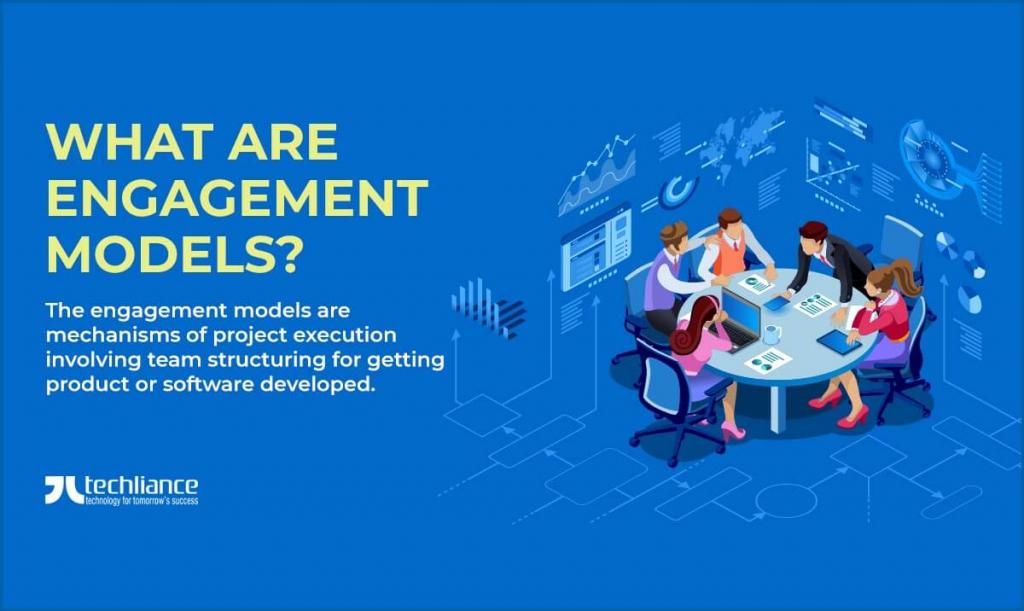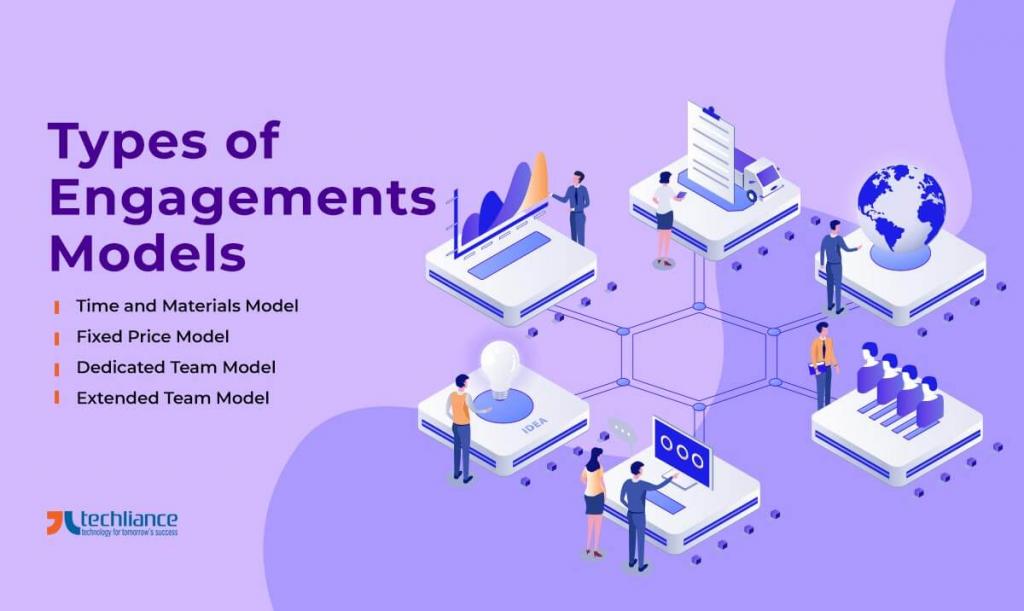Talking about software development, there are a variety of engagement models for creating software products. These engagement structures help companies understand the kind of business dynamics they want to get into for their project.
In a nutshell, engagement models are mechanisms of project execution involving team structuring for getting product or software developed.
Nowadays, companies are looking for smart, cost-effective, and agile-driven ways for better software product development. These engagement models emphasize the clever staff augmentation arrangement that can best suit businesses in 2024 and the future.

Types of Engagements Models
There are many kinds of engagement models including the following.
Now let’s have a closer look at these engagement models and the benefits they have for companies.
Time and Materials Model
This is an interesting engagement model for IT outsourcing. The time and materials model allows companies to broadly understand business needs and the total time required for the development. They look for resources (either dedicated or extended) to be attached to the project team.
Then the development team starts working daily on the project. You also pre-decide the rate for each IT resource. Similarly, you also need to account for the total hours of the work time.
Sometimes, you can even 50% allocate the technology resources in a time & materials (T&M) kind of engagement. This means that they will work for 4 hours daily till the end of their allocation.
T&M contract allows flexibility to rope in resources as required and take them off of the project. Hence, you pay for the hired services on the go.
Why use Time and Materials Model?
There are many advantages of the time and materials model such as:
- It’s ideal for projects where you can change requirements without having too much knowledge about what needs to be done.
- You have greater accountability of the resource activities, so you can question resources if the output is not per expectation.
- It helps you shape up project requirements with the help of industry experts, and you can deal with unforeseen factors.
- You only pay for the rendered services and not anything lump sum which helps you economize.
- It is easy to discontinue the T&M engagement model once the duration ends and project deliverables are in hand.
Fixed Price Model
Probably the most popular kind of team engagement structure is the fixed price model. It has many names like fixed time, fixed scope, fixed cost, and fixed bid. But they all mean the same and one thing.
This model deals with a wide percentage of certainty, where you have explored the market. Moreover, you are sure about what you want, without having any big obstacles in understanding. This allows you to clearly narrate the project scope.
Among the triple constraints of the project management, elaborated scope allows defining the time and cost of the project. Eventually, you can figure out what are the project timelines, and how many resources can make it happen. This in turn greatly improves the quality of the software project under development.
You can also see your flexibility on the MVP launch. And then you can fast-track the project by adding more resources to accelerate the delivery time of the software solution.
Where utilize Fixed Price Model?
There are many returns of fixed price model like:
- It is perfect for projects where you have great visibility about project requirements.
- You are in control of the entire project with proper execution, work breakdown, and how resources will work on activities.
- It is easy to incorporate waterfall, iteration, or agile engagement flavor to orchestrate your project. This is also dependent on your company culture and how you work in the industry. So, you can develop software projects timely and launch in the market early.
- You can constantly gauge project velocity, performance of the resources, and steer the project to ensure that it doesn’t derail.

Dedicated Team Model
The dedicated team model (DTM) is more about how resources will be associated with you. DTM is the kind of engagement model that blends well with a fixed price or T&M project undertaking. Therefore, a dedicated team gives you the complete dimension for running the show.
It means that you can completely outsource, or recruit a team for your project. This may include business analysts, designers, front-end developers, back-end coders, full-stack programmers, QA, and many other resources. Likewise, you can contract resources as per your requirement.
This helps the majority of businesses that don’t have IT professionals in their company. They can appoint dedicated resources or sub-contract the entire team of experts from a third-party technology firm. So, they can develop web or mobile-based solutions with the exclusive IT staff that is not fully contracted.
When to use a Dedicated Team Model?
There are many plus points of dedicated team model such as:
- It’s best for projects where you want to just hassle-free monitor project execution, so hire dedicated developers to do work.
- You can have complete transparency of your project endeavor with 1-1 progress meetings on a specific recurrence.
- All the project undertaking and the associated risks are borne by the hired IT agency.
- You have many companies to contract from worldwide, and it helps you minimize overhead costs (hiring, training, medical, etc.)
Extended Team Model
The extended team model (ETM) like the dedicated team model, is also an attachment to a fixed-price or T&M project. You target engaging a bunch of IT resources to become your extension, instead of hiring a full-on team. This is also known as the team extension model (TEM).
For example, you may have software developers in-house, but there is no one to do the QA. So, you can get a few QA resources to work alongside and extend your development team. They will then get on to temporarily become a part of your team.
Wherefore opt for Extended Team Model?
There are many profits of the extended team model including:
- It helps you get the best IT team together irrespective of their demographics.
- You remain in charge as you work closely with an in-house team, and monitor a remote extended team.
- Outsourced members of the extended team don’t cause you overheads as they are situated remotely.
- You can decide how to lead the way by defining all the WBS, tasks, and activities for the project team.

Conclusion
Speaking of 2024, you need to understand your business needs, project scope, budget, and time at hand. Then your decided engagement model takes care of the rest.
All of the engagement models have their pros and cons for the software projects. Many companies requiring IT resources feel that the dedicated team model and fixed price model are better. The time and materials model and extended team model are also popular and have various use cases.
Are you looking to start on a software project but don’t know how? Get, set, go with the best team appointment through Techliance today. Embark on your next software project endeavor through IT subcontracting now.




